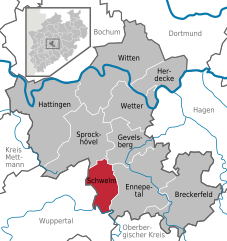Schwelm
| Schwelm | ||
|---|---|---|
 |
||
|
||
| Coordinates: 51°16′N 7°16′E / 51.267°N 7.267°ECoordinates: 51°16′N 7°16′E / 51.267°N 7.267°E | ||
| Country | Germany | |
| State | North Rhine-Westphalia | |
| Admin. region | Arnsberg | |
| District | Ennepe-Ruhr-Kreis | |
| Government | ||
| • Mayor | Gabriele Grollmann | |
| Area | ||
| • Total | 20.5 km2 (7.9 sq mi) | |
| Population (2015-12-31) | ||
| • Total | 28,330 | |
| • Density | 1,400/km2 (3,600/sq mi) | |
| Time zone | CET/CEST (UTC+1/+2) | |
| Postal codes | 58332 | |
| Dialling codes | 02336 | |
| Vehicle registration | EN | |
| Website | www.schwelm.de | |
Schwelm is a town in the district of Ennepe-Ruhr-Kreis in the administrative region of Arnsberg within the state of North Rhine-Westphalia.
Schwelm is situated in the southeast of the "Ruhrgebiet", the Ruhr district of Germany, between Westphalia and the "Bergisches Land". Schwelm is commonly known as the "Pforte Westfalens" ("Gate to Westphalia").
Surrounding towns include Ennepetal, Gevelsberg, Sprockhövel and Wuppertal.
Schwelm is called the "town of neighbourhoods". It is made up of the following 13 neighbourhoods:
The history of Schwelm can be traced back to the ninth century, where it is first mentioned as "Suelmiu". The city of Schwelm was officially established in 1496 and became seat of the Ennepe-Ruhr district in 1929. According to its area, Schwelm is the smallest town in North Rhine-Westphalia.
A Westphalian variety of high German is spoken in Schwelm (Westphalian: from old Saxon Westfal = "western land"). The Westphalian dialect belongs to the low Saxon dialects, which is a part of the family of low German dialects. Compared to other German regions (e.g., Bavaria or Swabia) the dialect does not have a strong influence on the everyday speech. Especially the elderly population is still able to speak Schwelm's original Westphalian tongue, called Schwelmer Platt, which is quite different from standard high German and bears a certain resemblance to Dutch.
Schwelm has got a particularly pretty historical town center with many old houses, some of which date back to the 18th century. The Altmarkt is a historical market place lying in front of the tall Christuskirche, the town's principal Protestant church. From the Altmarkt, the decorative street Kölner Strasse leads uphill and is part of the former road to Cologne.
...
Wikipedia




